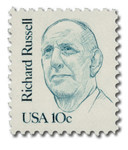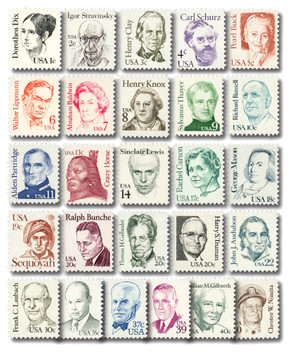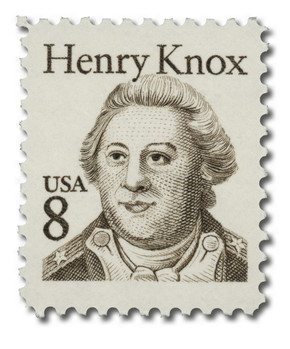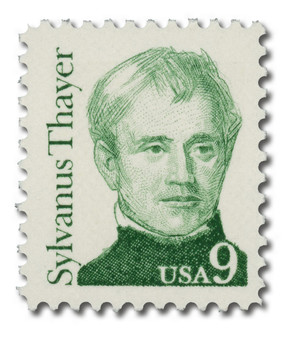
U.S. #1853
1984 10¢ Richard Russell
Great Americans
- 16th stamp in Great Americans Series
- First stamp printed on A Press with three pane sides sliced into straight edges
Stamp Category: Definitive
Series: Great Americans
Value: 10¢; half the first-class letter rate
First Day of Issue: May 31, 1984
First Day City: Winder, Georgia
Quantity Issued: 120,000,000
Printed by: Bureau of Engraving & Printing
Printing Method: Engraved
Format: Panes of 100
Perforations: 11
Color: Prussian blue
Why the stamp was issued: Shortly after Richard Russell’s death in 1971, people from his hometown of Winder, Georgia, as well as active and former Georgia politicians suggested he be honored on a stamp. A formal request was submitted to Congress in 1980, but no action was taken. Then, Congressman Ed Jenkins familiarized himself with the procedure for securing a stamp and formed the Richard B. Russell Commemorative Stamp Committee. The committee organized a publicity dinner, distributed brochures, and got the support of former president Richard Nixon. In November 1983, the USPS finally announced that a Russell stamp would be issued the following year on his 87th birthday. However, the issue date was later moved up to May 31, because of a need for 10¢ sheet stamps.
About the stamp design: Richard Sparks created the pen-and-ink drawing for this stamp from several different photographs.
About the printing process: This was the first stamp pane printed on the A Press to have three sides of the pane cut into straight edges. Prior to this, panes printed on the A Press had one or two straight edges and two or three perforated edges. The Bureau of Engraving and Printing (BEP) had found that the space between panes was too small, and attempts at slicing between perforated panes resulted in panes that were nor of “philatelic quality.” To resolve this issue, the BEP would start creating stamp panes with three straight edges. Most stamps will have one straight edge, but those from a corner may have two.
First Day City: The First Day ceremony for this stamp was held at Fort Yargo State Park in Russell’s hometown of Winder, Georgia. Representative Jenkins, who had pushed for the stamp’s creation, remarked, “Sitting there in the pavilion of Fort Yargo State Park listening to Postmaster General Bolger praise Senator Russell’s contributions and point out how fitting it was that he be honored in the Great Americans series, one would not have believed that the Postal Service had ever once objected to the issuance of that stamp.”
Unusual fact about this stamp: Imperforate between and imperforate horizontal error pairs have been discovered. Completely imperforate pairs have also been found and are classified as printer’s waste.
About the Great Americans Series: The Great Americans Series was created to replace the Americana Series. The new series would be characterized by a standard definitive size, simple design, and monochromatic colors.
This simple design included a portrait, “USA,” the denomination, the person’s name, and in some cases, their occupation or reason for recognition. The first stamp in the new series was issued on December 27, 1980. It honored Sequoyah and fulfilled the new international postcard rate that would go into effect in January 1981.
The Great Americans Series would honor a wider range of people than the previous Prominent Americans and Liberty Series. While those series mainly honored presidents and politicians, the Great Americans Series featured people from many fields and ethnicities. They were individuals who were leaders in education, the military, literature, the arts, and human and civil rights. Plus, while the previous series only honored a few women, the Great Americans featured 15 women. This was also the first definitive series to honor Native Americans, with five stamps.
The Bureau of Engraving and Printing (BEP) produced most of the stamps, but private firms printed some. Several stamps saw multiple printings. The result was many different varieties, with tagging being the key to understanding them. Though there were also differences in perforations, gum, paper, and ink color.
The final stamp in the series was issued on July 17, 1999, honoring Justin S. Morrill. Spanning 20 years, the Great Americans was the longest-running US definitive series. It was also the largest series of face-different stamps, with a total of 63.
Click here for all the individual stamps and click here for the complete series.
History the stamp represents: Richard B. Russell, Jr. (1897-1971) served in the US Senate for almost 40 years.
Born on November 2, 1897, Russell graduated from law school and served in the US Navy during World War I before setting up a law practice in Georgia in 1919. The young lawyer won his first elected position, in the Georgia House of Representatives, before his 24th birthday. He served in the state House for 10 years.
At only 33 years old, Russell became Governor of Georgia. The progressive politician tackled an unbalanced budget and promoted infrastructure development, even under the economic restraints of the Great Depression. Russell was a promising state governor. But when a Senate seat unexpectedly opened up in 1932, he campaigned to serve the rest of the vacated term, and won. Russell would go on to win six more times, serving in the US Senate from 1933 until 1971.
Russell supported New Deal programs that helped Georgians, such as rural electrification, free and low-cost student lunches, and farm loans. In the following years, Russell gained the respect of his fellow senators. He served as chairman of the Immigration, Manufactures, Armed Services, and Appropriations committees. He was also president pro tempore of the Senate for two Congresses.
Senator Russell was a segregationist and blocked civil rights legislation in the 1950s and ‘60s. When President Johnson signed the Civil Rights Act of 1964, Russell and other southern Senators boycotted the Democratic national Convention held later that year.
In spite of his stance on civil rights, Russell has been honored for the positive contributions he made while in the Senate. Office buildings, schools, and a lake now bear his name. Russell died on January 21, 1971.
U.S. #1853
1984 10¢ Richard Russell
Great Americans
- 16th stamp in Great Americans Series
- First stamp printed on A Press with three pane sides sliced into straight edges
Stamp Category: Definitive
Series: Great Americans
Value: 10¢; half the first-class letter rate
First Day of Issue: May 31, 1984
First Day City: Winder, Georgia
Quantity Issued: 120,000,000
Printed by: Bureau of Engraving & Printing
Printing Method: Engraved
Format: Panes of 100
Perforations: 11
Color: Prussian blue
Why the stamp was issued: Shortly after Richard Russell’s death in 1971, people from his hometown of Winder, Georgia, as well as active and former Georgia politicians suggested he be honored on a stamp. A formal request was submitted to Congress in 1980, but no action was taken. Then, Congressman Ed Jenkins familiarized himself with the procedure for securing a stamp and formed the Richard B. Russell Commemorative Stamp Committee. The committee organized a publicity dinner, distributed brochures, and got the support of former president Richard Nixon. In November 1983, the USPS finally announced that a Russell stamp would be issued the following year on his 87th birthday. However, the issue date was later moved up to May 31, because of a need for 10¢ sheet stamps.
About the stamp design: Richard Sparks created the pen-and-ink drawing for this stamp from several different photographs.
About the printing process: This was the first stamp pane printed on the A Press to have three sides of the pane cut into straight edges. Prior to this, panes printed on the A Press had one or two straight edges and two or three perforated edges. The Bureau of Engraving and Printing (BEP) had found that the space between panes was too small, and attempts at slicing between perforated panes resulted in panes that were nor of “philatelic quality.” To resolve this issue, the BEP would start creating stamp panes with three straight edges. Most stamps will have one straight edge, but those from a corner may have two.
First Day City: The First Day ceremony for this stamp was held at Fort Yargo State Park in Russell’s hometown of Winder, Georgia. Representative Jenkins, who had pushed for the stamp’s creation, remarked, “Sitting there in the pavilion of Fort Yargo State Park listening to Postmaster General Bolger praise Senator Russell’s contributions and point out how fitting it was that he be honored in the Great Americans series, one would not have believed that the Postal Service had ever once objected to the issuance of that stamp.”
Unusual fact about this stamp: Imperforate between and imperforate horizontal error pairs have been discovered. Completely imperforate pairs have also been found and are classified as printer’s waste.
About the Great Americans Series: The Great Americans Series was created to replace the Americana Series. The new series would be characterized by a standard definitive size, simple design, and monochromatic colors.
This simple design included a portrait, “USA,” the denomination, the person’s name, and in some cases, their occupation or reason for recognition. The first stamp in the new series was issued on December 27, 1980. It honored Sequoyah and fulfilled the new international postcard rate that would go into effect in January 1981.
The Great Americans Series would honor a wider range of people than the previous Prominent Americans and Liberty Series. While those series mainly honored presidents and politicians, the Great Americans Series featured people from many fields and ethnicities. They were individuals who were leaders in education, the military, literature, the arts, and human and civil rights. Plus, while the previous series only honored a few women, the Great Americans featured 15 women. This was also the first definitive series to honor Native Americans, with five stamps.
The Bureau of Engraving and Printing (BEP) produced most of the stamps, but private firms printed some. Several stamps saw multiple printings. The result was many different varieties, with tagging being the key to understanding them. Though there were also differences in perforations, gum, paper, and ink color.
The final stamp in the series was issued on July 17, 1999, honoring Justin S. Morrill. Spanning 20 years, the Great Americans was the longest-running US definitive series. It was also the largest series of face-different stamps, with a total of 63.
Click here for all the individual stamps and click here for the complete series.
History the stamp represents: Richard B. Russell, Jr. (1897-1971) served in the US Senate for almost 40 years.
Born on November 2, 1897, Russell graduated from law school and served in the US Navy during World War I before setting up a law practice in Georgia in 1919. The young lawyer won his first elected position, in the Georgia House of Representatives, before his 24th birthday. He served in the state House for 10 years.
At only 33 years old, Russell became Governor of Georgia. The progressive politician tackled an unbalanced budget and promoted infrastructure development, even under the economic restraints of the Great Depression. Russell was a promising state governor. But when a Senate seat unexpectedly opened up in 1932, he campaigned to serve the rest of the vacated term, and won. Russell would go on to win six more times, serving in the US Senate from 1933 until 1971.
Russell supported New Deal programs that helped Georgians, such as rural electrification, free and low-cost student lunches, and farm loans. In the following years, Russell gained the respect of his fellow senators. He served as chairman of the Immigration, Manufactures, Armed Services, and Appropriations committees. He was also president pro tempore of the Senate for two Congresses.
Senator Russell was a segregationist and blocked civil rights legislation in the 1950s and ‘60s. When President Johnson signed the Civil Rights Act of 1964, Russell and other southern Senators boycotted the Democratic national Convention held later that year.
In spite of his stance on civil rights, Russell has been honored for the positive contributions he made while in the Senate. Office buildings, schools, and a lake now bear his name. Russell died on January 21, 1971.















